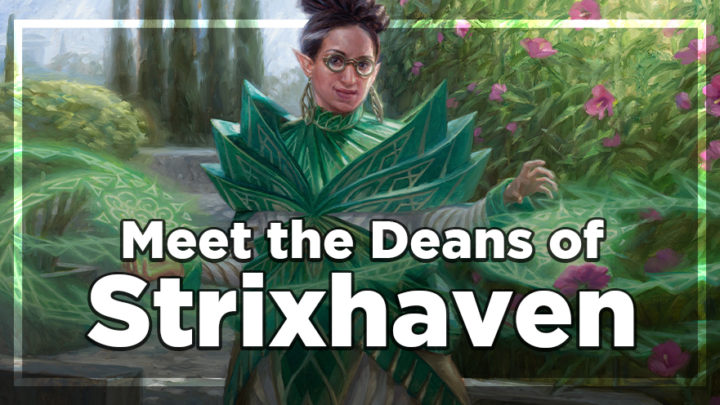Since as far back in Magic design as Ravnica: City of Guilds, WotC has embraced using powerful legendary creatures to anchor the identity of a set’s signature archetypes or factions. This habit has only been reinforced by the mechanical need to support these factions in the Commander format. So as soon as it became clear that Strixhaven: School of Mages would debut several new multicolor Colleges, I was rubbing my hands together to wait and see what they’d get in the way of leadership.
The deans deliver, harnessing the current centerpiece Standard mechanic of MDFCs to present contrasting facets of these two-color Colleges in a single card. It’s a clever and powerful design tool which sets these new legends further apart from their Ravnican counterparts we’ve seen over the years. While these deans aren’t even the only legends leading the Colleges of Strixhaven – we’re also getting some very powerful founder dragons – they do have an exciting niche. Their cost and utility could find them roles anywhere from Standard to Commander to older Constructed formats.
DOUBLE THE DEAN, DOUBLE THE FUN
Before we evaluate the individual cards in this cycle, I think it’s worth emphasizing how central the modal double-faced card rules are to their design and play. I was really impressed by how the legendary gods of Kaldheim were improved by having a different spell on the back side. It lets you play a full four of something powerful and central to your deck without the feel-bad hands where you draw multiple redundant copies. It can also offer a more reliable or cheaper backup spell to help justify including an expensive or risky payoff in low-curve decks which can’t afford to sacrifice consistency for power.
Each of the five dual-faced dean cards are designed to provide both setup and payoff in a single card, although I’m glad to see pains were taken to make sure the individual sides were good on their own. As a result, we have the potential to assess these cards even for strictly monocolored decks — I don’t expect it to be common, but a few of these cards might be good enough to show up in lists even without the added value of a second side. That’s another new kind of flexibility the MDFC mechanic can bring to the game, and I really do hope it never goes away.
VALENTIN, DEAN OF THE VEIN//LISETTE, DEAN OF THE ROOT (WITHERBLOOM)
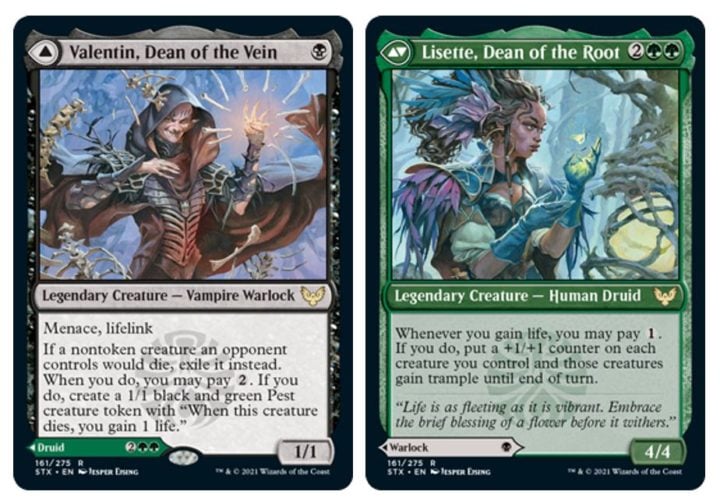
We begin with the most obviously Constructed-playable of the cycle, the Witherbloom deans. What makes them the most playable? A lot of it is simply having the black side, Valentin, at a mana value of one — especially given his powerful, Kalitas-lite hatebear effect.
If you haven’t had the joy of playing with the Traitor of Ghet (or Anafenza, the Foremost), these abilities mess with recursion engines and creature combos as well as any random value an opponent would get from “dies” triggers. The token side of the trigger will be a nice mana sink, both in controlling lists as a way to generate chump blockers off your removal and for aggro decks which often struggle to maintain tempo and spend their mana effectively after curving out.
Valentin’s menace and lifelink abilities are subtle nods toward aggro decks like BW Auras or Abzan Counters, which can build a bigger body to utilize them. Sure enough, the green dean Lisette is a powerful enabler for the counters deck, although in keeping with the idea of each side being independent, she’s also got synergy with lifegain and go-wide themes. There’s plenty of crossover between these effects both in Standard and older formats with decks like Soul Sisters. Even if the card’s inclusion there comes largely on the strength of Valentin’s cheap hatebear ability, having a 4/4 for four mana with real text as a free option is a substantial bonus.
PLARGG, DEAN OF CHAOS//AUGUSTA, DEAN OF ORDER (LOREHOLD)
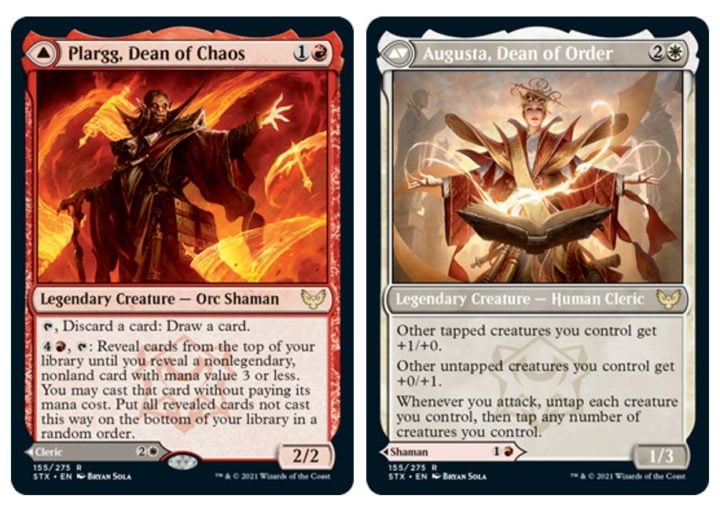
I’m a big fan of the Lorehold deans in spite of – or maybe because of – their lack of direct synergy. All the deans are self-sufficient, but these two want to be in completely different Standard decks! Plargg is a solid backup effect for the currently under-supported Magmatic Channeler, which is most commonly seen in black-red or blue-red decks to play off graveyard or spellslinger synergies not seen in red-white. It’s possible Lorehold will fill that void with some of their other cards, but for now, Plargg feels a bit out of place there.
But on the flip side, Augusta is definitely a fit for red-white, with the most obvious payoff for her very powerful trigger coming from Magda, Brazen Outlaw. In addition to stacking buffs for attacking Dwarves, this legendary duo can power out an incredibly fast Velomachus Lorehold. That flexible aggro-combo threat seems like a solid foundation for a deck, but it’s hard to see Plargg fitting into it, since his second ability won’t hit any relevant cards. It’s enough of a disparity to make me wonder whether he was a Dwarf Shaman at some point in development, especially since they are more clearly associated with Lorehold to start with…
Players who want to get equal usage out of both sides of this card may have to turn to Commander, but at least their prospects there look very bright. Once you open up the eternal card pool, we find no shortage of viable red and white creatures that do exciting things with Augusta’s unique ability, while being cheap enough to both hit off (and justify) Plargg’s activations. Lorehold is in some ways a gift to players who have spent years pining for less single-minded beatdown from their red-white decks, and these deans really fit that bill.
KIANNE, DEAN OF SUBSTANCE//IMBRAHAM, DEAN OF THEORY (QUANDRIX)

The blue-green deans are a little less pushed in terms of Constructed viability — which, considering the dominance of this color combo in recent years, is probably for the best. Kianne and Imbraham seem too passive and mana-hungry for the present pace of Standard, or really any format. They also rely far more on direct synergy with each other than the other dean pairs, which is a problem given they compete for the same resources and have similar weak points.
As a 2/2 for three mana, Kianne is vulnerable to everything from Stomp to Eliminate to Elspeth’s Nightmare. The cost of her token-creating ability means you miss another turn before she even provides a chump blocker, which feels extremely harsh when you imagine the pressure Mono-Red or Mono-White can exert in that timeframe. The best case scenario is ramping turn two, casting her on three and making a Fractal turn four — but that’s still two whole turns you put yourself behind for a 2/2 making 1/1s. Worst of all, if her first tap ability draws a land you have no option to exile it — meaning her token ability is completely offline until she hits one. Biogenic Ooze, this ain’t.
Imbraham does offer a quick fix here: his own activated ability is capable of supercharging Kianne’s tokens on the spot. Unfortunately, while the blue dean does slot nicely between Kianne’s casting and activation costs, there’s additional awkwardness around this proposed curve. The fact that Imbraham uses a tap ability with a relatively substantial activation cost instead of an attack trigger means you can’t expect to charge up and utilize Kianne’s token ability on the same turn, leaving a likely three-turn window where the Quandrix player spends all their mana and produces no viable blockers. That’s nearly impossible to justify, no matter how nice your token production is afterwards.
So if casting these deans on curve is a death sentence, how can we use them effectively? To me, Imbraham holds solid potential in either mono-blue or blue-green ramp decks. He’s a 3/3 flyer that can utilize the same untap effects as Nyx Lotus while exiling chunks of the deck to set up Thassa’s Oracle; the floor and ceiling feel good enough to justify playing him, whether Kianne is castable or not.
If we do want Kianne to get value, it needs to be late-game, when Imbraham has already exiled some cards and you can use some spare mana to create one or more large Fractals. The rules for flickering mean that Thassa, Deep-Dwelling can “transform” Imbraham into Kianne at the end step, while most of your mana rocks – including Nyx Lotus in a pinch – can produce green mana to utilize her instant-speed ability. Of course, this one-two play pattern of deans is an even better fit for Commander, where you can simply wait until Imbraham returns to the Command Zone before switching to deploy your devoted Fractal mamma.
SHAILE, DEAN OF RADIANCE//EMBROSE, DEAN OF SHADOW (SILVERQUILL)
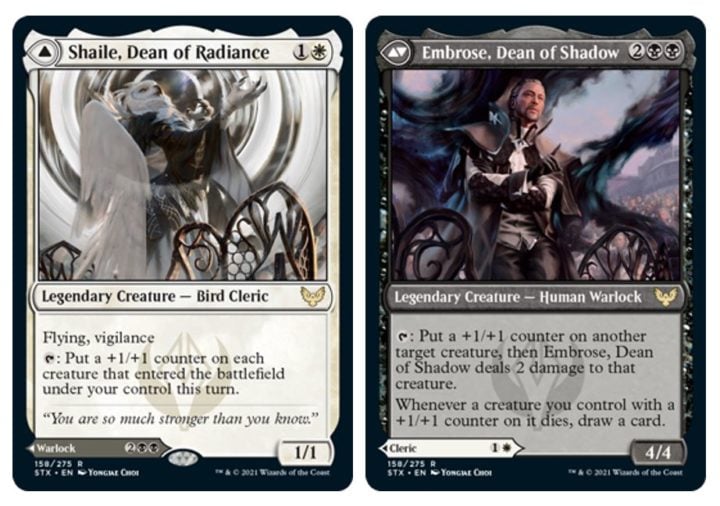
Silverquill’s deans reinforce my hunch from our predictions article that this would be the “small creature aggro College.” Shaile is the big draw here; while a two-mana 1/1 is by no means an easy inclusion in Standard, she is able to slot into synergistic shells with various Clerics and “cares about counters” cards across Abzan colors. In older Constructed formats with Collected Company and other ways to churn out cheap creatures or tokens, this Bird could be a big winner. Lurrus and Agadeem’s Awakening look to boost Shaile’s potential wherever she goes, and like her Witherbloom colleague Valentin, her keywords hint at some bonus value for decks that can pump her up a bit.
Unfortunately, Embrose turns out to be something of a disappointment, and not only to his son Killian. Having access to a 4/4 for four mana in these colors is nice, but having him not be a Cleric hurts badly when Shaile seems so angled towards that archetype. His tap ability is also ineffectual for his cost; a modal choice between Luminarch Aspirant, Ayara and Prodigal Sorcerer. The static ability seems nice, but why can’t it trigger off opposing creatures when Embrose’s active is capable of targeting them? It would at least let him imitate yet another more mana-efficient creature.
Barring some significant later spoiler which unlocks hidden potential for Embrose (perhaps Human tribal?), it seems correct to include this based on how much your deck wants Shaile, with the black dean as a potential bonus piece of wrath protection. And you know what? That’s perfectly fine. I chalk it up as simply another way to design and balance these MDFCs.
UVILDA, DEAN OF PERFECTION//NASSARI, DEAN OF EXPRESSION (PRISMARI)
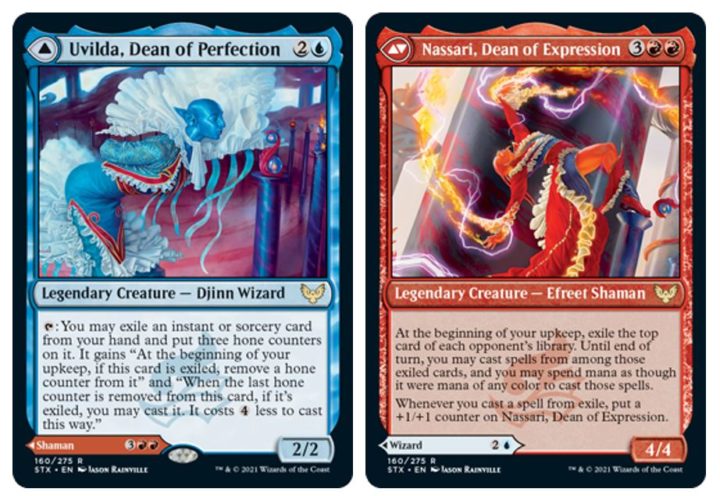
It’s fitting that the Prismari score the coolest concept among all the deans, with rival/mirrored Djinn and Efreet hammering home the duality these Colleges represent. This card also easily has both the highest mana value and the most lines of text in this cycle, but this dramatic duo bring an appropriate payoff.
Uvilda is practically Jhoira of the Ghitu, albeit for instants and sorceries. You’ll want a sizable payoff for this delayed-impact ability, and the fact that you have to cast the “honed” spell in your upkeep as the last counter is removed means it’s going to be something proactive and broadly good. Luckily, big, splashy sorceries seem to be a speciality for the Prismari, so there should be plenty of options to choose from.
Cycling mechanics we’ve seen in other Prismari previews mean you’ll be able to play a higher density of their big-mana payoffs than normal, ensuring Uvilda always has a ready spell in hand to start honing. Another argument for Uvilda is that she only has to live long enough to get that initial tap activation — removing her after that stops further cards being honed, but will not interfere with the honing or casting of the first.
Nassari is costly, but very powerful, even for red decks with no way to cast his fellow dean. His first ability gives yet another way for red to keep strong tempo into the late-game, especially for multiplayer. But his second ability is the real treat, as it has many impressive synergies in Standard (adventures, foretell, Showdown of the Skalds), and in older formats, you can easily set up to grow Nassari far beyond 4/4 on his first or second turn in play.
This is probably the duo I’m most excited to bring to Commander as well. Blue-Red Spellslinger can often turn into “free spell tribal” in Commander, and depending on where you are in the game, you can drop these two into play as either the perfect setup or explosive payoff to such a deck — exactly the kind of smoothing I’m looking for in the Command Zone or the 99. I’m sure their case there will only improve as we see more impressively large and fun Prismari spells to play around with.
CHANGE WE DEIGN TO NOTICE
Overall, this cycle has really driven home how much the MDFC mechanic is a masterstroke. As with the last few sets, the deans are showing off how this card type can patch up the worst-feeling issues Magic has with draw step variance, without leading to repetitive or dull play patterns. The choice to be able to play the dean you most need — with the two sides benefiting but not wholly depending on each other — allows for radically more creative deckbuilding in colors without traditional card selection. Having two deans in one elegantly works around the legend rule, and the different stats and costs smooth out your curve in archetypes like weenie aggro, which could scarce afford the extra four-drops under normal circumstances.
Beyond that, the flexibility to play a card like Nassari in a red deck which rarely or never casts Uvilda is really cool to me, and even if it might be only a fringe possibility, it shows how brilliantly open this dual-legend card concept is. We have the founder dragons to show the combined-color aspect of each College, and these distinct single-color deans make a lovely complement to that, fleshing out our understanding of these organizations.
But it’s maybe Commander where I’m most excited for this specific use of MDFCs. It’s a far better balanced version of the partner mechanic, and in a format where nearly every deck relies on value engines and setup-plus-payoff gameplay, I think the chance to plug in either side of that equation as needed makes up for the inherent barrier to getting both deans into play simultaneously. I’m excited to see the deans shooting up the ranks of established community faves and the different approaches our community takes to building with them!

Tom’s fate was sealed in 7th grade when his friend lent him a pile of commons to play Magic. He quickly picked up Boros and Orzhov decks in Ravnica block and has remained a staunch white magician ever since. A fan of all Constructed formats, he enjoys studying the history of the tournament meta. He specializes in midrange decks, especially Death & Taxes and Martyr Proc. One day, he swears he will win an MCQ with Evershrike. Ask him how at @AWanderingBard, or watch him stream Magic at twitch.tv/TheWanderingBard.

